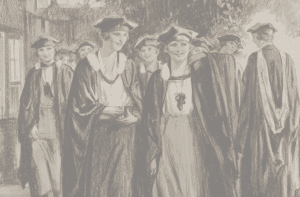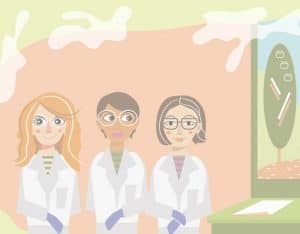A pile of dry leaves, the rain, a puddle, touching clay with your bare hands, seeing the rainbow, or feeling that I am going to fly because of the wind. Machines, robots, and tools; starting with a needle and all that can be achieved achieve if you have some thread and learn how to use it. Over all, however, people. I am really moved by people. What about you? What moves you?
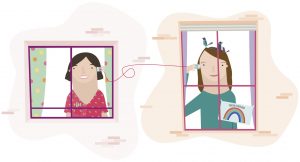
© Beatriz Entralgo. All rights reserved.
I began telling stories about women in science because, throughout my life, I have met many more women who are scientists than princesses. Nevertheless, I had the feeling that in films, cartoons, toy shops, and even in textbooks and the news; this looked the other way round, as if there were many more princesses than women scientists. I decided to start telling about women scientists because I only found out who Virginia Apgar was almost 20 years after having studied Medicine…
My way of telling stories is very simple. I read all that I can about the person I want to talk about, I learn many details about them and, when the time to tell their story comes, I only explain two or three of them. Why? Because those were the details that moved me, and I want to convey more than just information that you can easily read somewhere else. I want people to feel touched by what I explain to them, while sharing the sources of information that I consider reliable. In that way, when people need to get water on their own, they will know where the water source is.
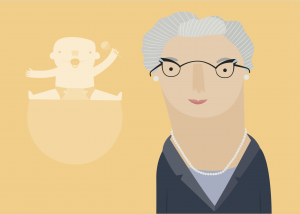
© Beatriz Entralgo. All rights reserved.
Out of all my anatomy classes, there is one I remember as if I was still there, sitting in one of the back rows of the classroom. The lecturer for group B was there, because the one for group A had called in sick. He had never taught our group before. We were used to master classes with lots and lots of talking and a few chalk drawings on the blackboard (very good drawings, I must say). The lecturer that day did not draw anything. He just explained the skull bones using very few words. To do this, he took advantage of his baldness. If now I close my eyes, I can still see him, back turned to us, and pointing at his own head while talking about the occipital bone.
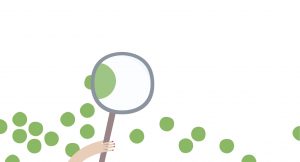
© Beatriz Entralgo. All rights reserved.
So then, why am I writing this blog post here and now? It is possible that, if you are reading this, you are researching something very interesting and you want to share it with other people who know nothing about that topic in which you are an expert. Adults, a group of boys and girls, a class of teenagers, a motley crew of people…, you name it! Maybe you do not even know who your audience is going to be when you tell your story. I will let you know what I do when I am in such a situation, in case it is helpful for you. Before I start talking, I take a moment and look around and breathe. Then, I remind myself what moves me about what I am about to tell the audience. I think of the occipital bone and I use all the resources I have acquired throughout my experience to tell what I came to tell, in simple words. Under this idea, Cuentacientíficas (i.e., storytelling about women scientists) [1] was born to promote the 11F initiative [2] and to achieve the fifth sustainable development goal [3]: to ensure that gender equality becomes a reality and to promote the empowerment of all women and girls. Illustrator Beatriz Entralgo and myself started this project planning activities aimed at a general audience, which later have been redirected for a family audience.
During the lockdown triggered by the COVID-19 pandemic, our work has continued online. We have made short videos to tell about women scientists and even to show how arts-and-crafts activities. Here are some links as examples. Will you tell about women scientists?
* * *
By Águeda Giráldez (@agdagira), co-founder of Cuentacientíficas.
More information:
- Cuentacientíficas.
- 11F iniciative.
- Sustainable development goals.
- PDF files for the activities carried out during the 11F initiative.
Resources developed by Cuentacientíficas you might like to take a look at (in Spanish):
- Turn the classics upside down. Listen to the story ‘The scientist and the pea’ – Paint the illustrations.
- We introduce you to Doña Angelita. Ángela Ruiz Robles, inventor of the mechanical encyclopedia, precursor to the e-book – Learn how to make your own minibook to tell stories about women scientists.
- Have you ever heard about Operation Balmis? What about the first nurse in an international mission? – Learn how to make an Isabel Zendal bookmark.
- Build a mobile and fill it up with your favourite women scientists.
- Fly with Ada Lovelace. The first-ever programmer wanted to build a steam-powered mechanical winged horse to fly when she was young – Build your own winged horse recycling cardboard rolls.
- Fold an origami envelope and fill it up with cards to tell your stories about women scientists. Count with Maria Andresa Casamayor, dream with Ada Lovelace, discover with Marie Curie and learn with Alice Gray.

